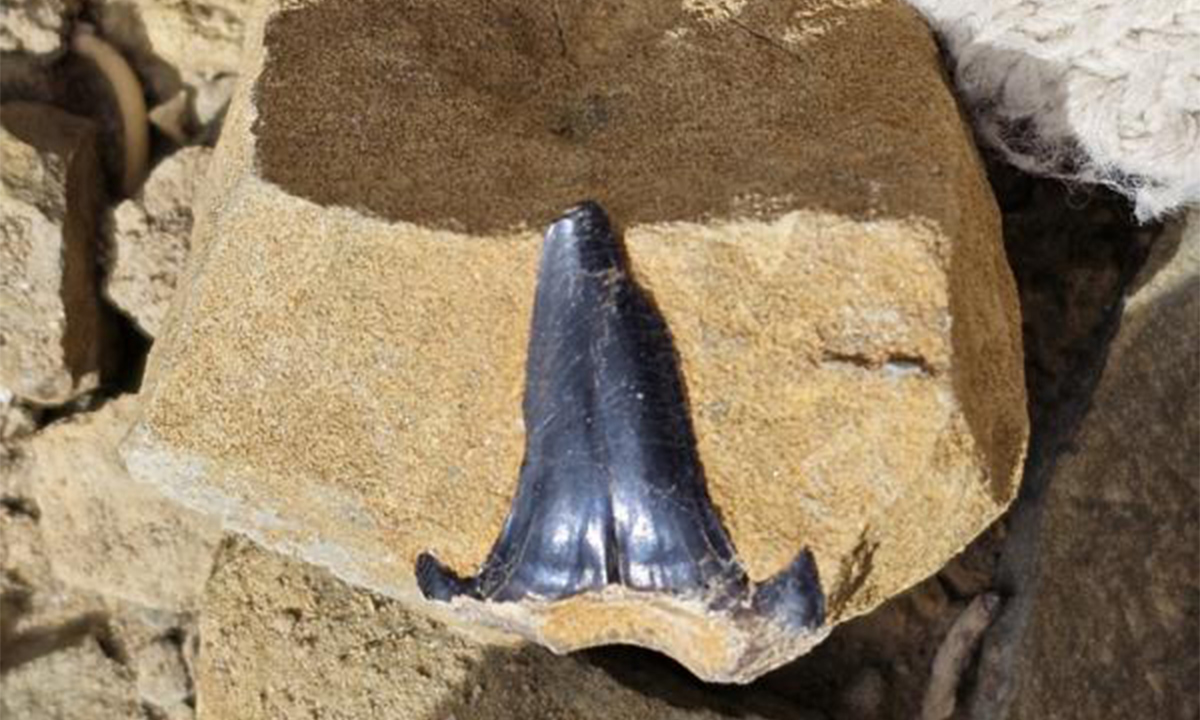
The fossil of a shark tooth from 220 million years ago Photo:CCTV
The fossil of a shark tooth from the Late Triassic period dating back 220 million years has been found by a Chinese research team during a recent scientific expedition on the Mount Cho Oyu, Himalayas, on the Qinghai-Xizang Plateau, according to the state-run broadcaster CCTV.
Mount Cho Oyu, part of the renowned Himalayan mountain range, stands as the world's sixth-highest peak, towering at an elevation of 8,201 meters. The scientific team composed of the Institute of Vertebrate Paleontology and Paleoanthropology (IVPP) under the Chinese Academy of Sciences and the Xishuangbanna Tropical Botanical Garden.
Deng Tao, director of the IVPP, said "This discovery will provide invaluable insights into the prehistoric marine ecosystems of the Late Triassic period (at the region)."
Additionally, the expedition members found a heteromorphic ammonite fossil from the Late Cretaceous strata, dating back approximately 70 million years. This discovery sheds light on genetic disorders in certain biological groups prior to the fifth major mass extinction event, which happened about 66 million years ago and killed off the nonavian dinosaurs and made room for mammals.
Ammonites were widely distributed in the Triassic oceans around the world but became entirely extinct at the end of the Cretaceous period. These creatures are renowned among geologists as index fossils for dating rock formations. For instance, Jurassic ammonite fossils are commonly found in the Mount Himalaya.
Furthermore, fossils of plants, including berberis, cotoneaster, spruce, dating to the Early Pliocene epoch, approximately 5 million years ago, were discovered in strata at an altitude exceeding 4,800 meters on Mount Cho Oyu. These findings suggest the existence of a coniferous forest community in the era, signifying that during the uplift of the Qinghai-Xizang Plateau, the Himalayas had already reached an elevation of over 3,000 meters, according to the report.
"Some of the fossilized leaves resemble cotoneaster and spruce leaves," said Yang Yongping, researcher of the Xishuangbanna Tropical Botanical Garden, adding that "In the coming days, we will conduct more in-depth research on the age of the strata and the fossil specimens."
The scientific base camp is located at 4950 meters on Mount Cho Oyu. This expedition encapsulates the geological, climatic, environmental, and biological evolution of the Qinghai-Xizang Plateau over millions of years, offering the potential to illuminate the history of environmental change and life evolution on the plateau and providing insights into the life forms of the ancient Paleo-Tethys Ocean over 200 million years ago, according to Deng.
The Qinghai-Xizang Plateau stands as a vital hub for biodiversity evolution, and paleontological fossils not only serve as crucial evidence for the evolution of life but also as valuable resources for understanding geological periods, environmental shifts, and climate changes.
The 2023 Mount Cho Oyu research mission is part of the second comprehensive scientific expedition on the Qinghai-Xizang Plateau, which was initiated in 2017.
Launched in late September this year, it is comprised of over 120 scientists. On October 2, 18 scientific research team members successfully erected an automatic weather station at the peak altitude of 8201 meters of Mount Cho Oyu, which is the second 8000-meter level automatic weather station in China.
Besides, the interdisciplinary team is carrying on work including investigating water resources, ecological dynamics and carbon cycling, human activities and environmental safety, mineral resources, geological environment, and other scientific inquiries, to pave the way for a deeper comprehension of high-altitude ecosystems.
URL: https://www.seeglobalnews.com/read-2455.html